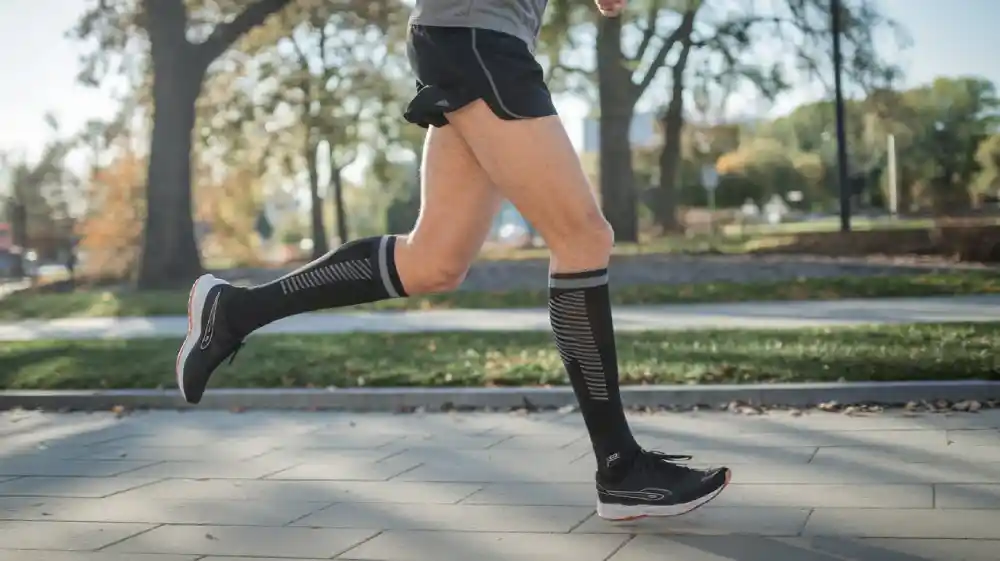
In recent years, compression socks have evolved from a niche recovery tool to an essential piece of gear for serious runners. What was once reserved for athletes recovering from injury is now a mainstream solution for improving performance, reducing fatigue, and speeding up recovery. The rising demand isn’t just a trend; it’s a shift in how runners approach their sport and their bodies. From marathoners to weekend warriors, athletes are turning to compression technology to optimize their training and performance. But why? This surge in popularity is transforming the compression sock market, creating a unique opportunity for brands and retailers to tap into a rapidly growing segment. In this post, we’ll dive into the business side of the trend, unpacking the factors driving demand and how you can capitalize on it. The time to understand this movement is now—before your competitors do.
What Are Compression Socks? Definition and Types
Compression socks are designed to apply pressure to the lower legs and feet to improve blood flow and reduce swelling. Unlike regular socks, which only cover the feet, compression socks help with muscle recovery, injury prevention, and performance. Their primary purpose is to increase circulation and reduce muscle fatigue during physical activity.
There are two main types: compression socks and calf sleeves. Compression socks cover the entire foot and leg, providing support from the toes to the knee. Calf sleeves, on the other hand, focus on the calf area, leaving the feet exposed. Runners often choose calf sleeves to target the legs without constricting the foot.
Materials Used in Compression Wear: Nylon, Spandex, and More
- Nylon / Polyamide
Nylon is strong and durable, making it ideal for compression gear that needs to withstand wear and tear. However, it’s less breathable, so it may trap moisture, making it uncomfortable for sweaty feet.
How to test nylon: Burns slowly, smells like celery, and forms a brown ball. - Cotton
Cotton is soft, absorbs moisture well, and is eco-friendly, but it lacks the durability and stretch of synthetic fibers. It’s better for daily wear than high-performance compression.
How to test cotton: Doesn’t melt, smells like burning paper, and leaves gray or white ash. - Polyester
Polyester is durable, elastic, and resistant to wear. However, it’s not the most breathable option and doesn’t wick away moisture as effectively as other materials.
How to test polyester: Melts when burned, smells like sweet chemicals, and forms a hard black ball.
How Compression Socks Address Common Running Challenges and Enhance Performance
Runners regularly face challenges like muscle fatigue, swelling, and cramping, which can hinder their performance and recovery. Compression socks provide an effective solution by tackling these issues directly, offering measurable benefits during both activity and recovery.
Improving Circulation and Reducing Muscle Fatigue
Compression garments apply controlled pressure to the legs, which helps improve blood circulation and oxygen delivery to the muscles. This enhanced circulation reduces muscle fatigue, swelling, and cramping during runs by ensuring that oxygenated blood reaches the muscles more efficiently. According to research, compression socks help lower perceived muscle soreness and fatigue. Additionally, by promoting better circulation, these socks move fluid back into the bloodstream, reducing swelling and preventing cramps, allowing athletes to maintain better performance and comfort throughout their runs.
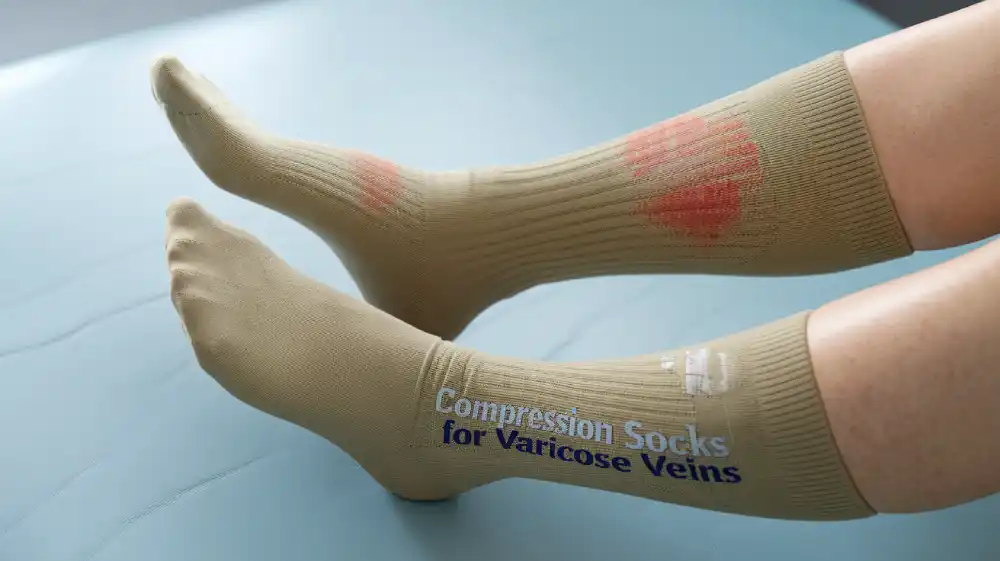
Preventing Shin Splints and Varicose Veins
Compression socks also offer significant protection against common running injuries, such as shin splints and varicose veins. Shin splints are caused by repetitive stress on the lower legs, and varicose veins arise from poor blood flow, causing swelling and discomfort. Compression wear helps to stabilize muscles and joints, reducing the risk of shin splints. It also improves venous return, addressing swelling and alleviating symptoms of varicose veins. Research suggests that compression reduces the impact of repetitive leg movements and supports better venous function, ultimately lowering the risk of these injuries.
Enhancing Recovery and Preventing Overuse Injuries
Post-exercise recovery is critical for runners, and compression socks play a key role in accelerating this process. By improving circulation and aiding in the removal of metabolic waste products, such as lactic acid, compression socks help reduce muscle soreness and inflammation after intense workouts. Studies have shown that wearing compression garments post-exercise leads to faster recovery and reduced muscle damage. In addition, compression socks help prevent overuse injuries by providing stability to the muscles, reducing the strain during repeated motions, and protecting against fatigue and muscle strain.
By incorporating compression socks into their training and recovery routines, runners can address common pain points like muscle fatigue, swelling, and cramping, reduce the risk of injuries such as shin splints and varicose veins, and accelerate recovery, enabling them to stay at peak performance for longer.
Who Should Wear Compression Socks? Usage Suggestions and Contraindications
Compression garments are widely used for their benefits in boosting performance and enhancing recovery, but they aren’t suitable for everyone. Understanding when they should be worn and when they should be avoided is essential.
Ideal Candidates for Compression Wear: Runners, Athletes, and Active Individuals
Compression socks are especially useful for individuals who engage in intense physical activity. These include:
- Runners who experience muscle fatigue and require quicker recovery.
- Endurance athletes, such as marathoners and cyclists, who often push their muscles to the limit.
- Active individuals who participate in regular physical activity and need muscle support.
By improving circulation, reducing swelling, and providing muscle stability, compression wear enhances endurance and speeds up post-exercise recovery. These benefits help athletes maintain peak performance and avoid muscle strain.
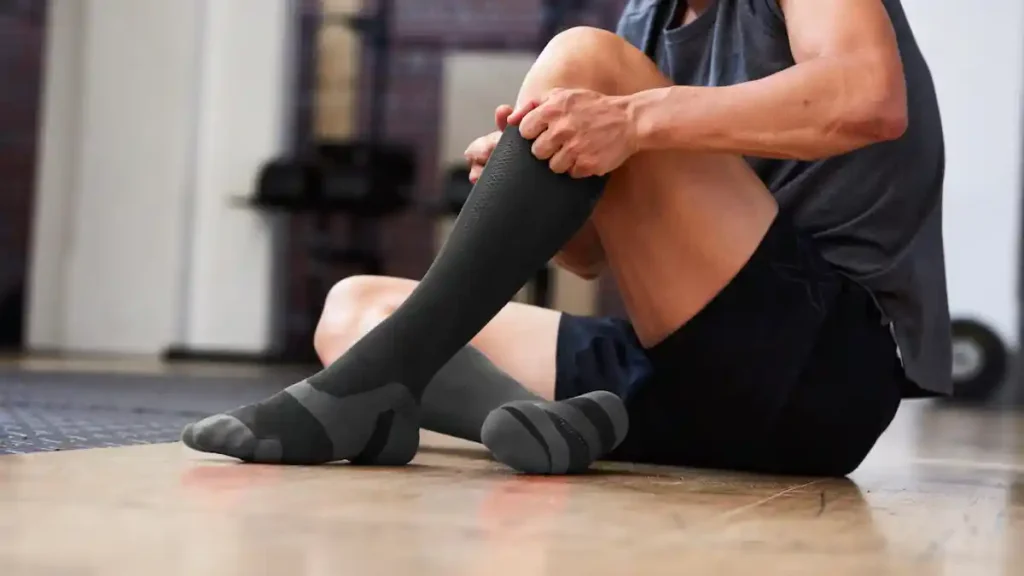
When Compression Wear Is Not Recommended: Contraindications and Medical Warnings
Though compression socks offer numerous advantages, they are not appropriate for everyone. There are specific conditions where these garments should be avoided:
- Peripheral Artery Disease (PAD): Those with PAD should avoid wearing compression wear, as it may worsen circulation problems.
- Severe skin conditions: Open wounds, ulcers, or infections in the legs may be aggravated by wearing compression garments.
- Uncontrolled cardiovascular issues: Compression socks can increase pressure in the veins, potentially worsening heart conditions or fluid retention. Consulting a healthcare professional is advised before use in such cases.
For individuals with these conditions, it’s important to seek medical advice before using compression gear.
Usage Time: How Long Should They Be Worn During and After Activity?
The optimal duration for wearing compression socks depends on the situation:
- During Activity: Compression socks should be worn throughout the run or workout, especially during long-duration exercises. They help manage muscle strain, reduce vibration, and support better circulation.
- Post-Activity: Wearing them for 1-2 hours after physical exertion can significantly aid recovery by reducing muscle soreness, minimizing swelling, and speeding up lactic acid clearance.
How to Choose the Right Compression Socks: A Guide for Consumers
Choosing the right compression gear can significantly improve a runner’s performance and recovery. With so many options on the market, understanding key factors will ensure a better fit, greater comfort, and maximum benefit.
- Avoiding Medical Compression Stockings
Medical compression stockings are designed to treat specific health conditions like poor circulation or varicose veins. While they help with these issues, they are not appropriate for athletic use. These garments typically provide a uniform level of pressure across the entire leg, which can impede circulation during physical activity. For active individuals, socks designed for sports use offer graduated compression (stronger at the ankle and less at the top), which improves blood flow during exercise, reduces muscle fatigue, and supports recovery.
- Focusing on Materials
The material of your compression socks plays a critical role in comfort and performance. Choose fabrics that are breathable and moisture-wicking to keep your feet dry and prevent discomfort. Nylon, merino wool, and polyester are excellent choices for athletic socks, as they allow moisture and heat to dissipate, reducing friction and minimizing the risk of blisters. Nylon is known for its durability and strength, merino wool offers natural breathability and odor resistance, while polyester helps with quick-drying properties. Avoid cotton, as it tends to absorb moisture and can lead to chafing during prolonged physical activity.
- Pressure Levels for Different Needs
Compression socks vary in the amount of pressure they provide, typically measured in mmHg (millimeters of mercury). Choosing the correct pressure is essential for effective support:
- Light compression (15-20 mmHg): Suitable for general exercise, providing mild support to reduce fatigue.
- Medium compression (20-30 mmHg): Ideal for longer workouts or runs, reducing soreness and enhancing circulation.
- High compression (30-40 mmHg): Best for intense use, such as during injury recovery or long-distance events, helping to prevent swelling and cramping.
Selecting the appropriate level depends on the type of activity and specific needs, whether you’re focused on improving endurance or managing muscle recovery.
- Finding the Right Size
To ensure compression socks provide optimal benefits, it’s important to get the right fit. Socks that are too tight can restrict circulation, while those that are too loose won’t offer the required support. The first step is to measure your ankle and calf circumference. Refer to the manufacturer’s size chart to find the best match for your measurements. Also, consider sock length—knee-high socks provide full leg support, while calf-length socks might be sufficient for less intense activities. A proper fit is one that feels snug but not restrictive, offering support without discomfort.
By paying attention to materials, compression levels, and sizing, runners can ensure that their compression socks will provide maximum benefit, enhancing their performance, preventing injury, and speeding up recovery.
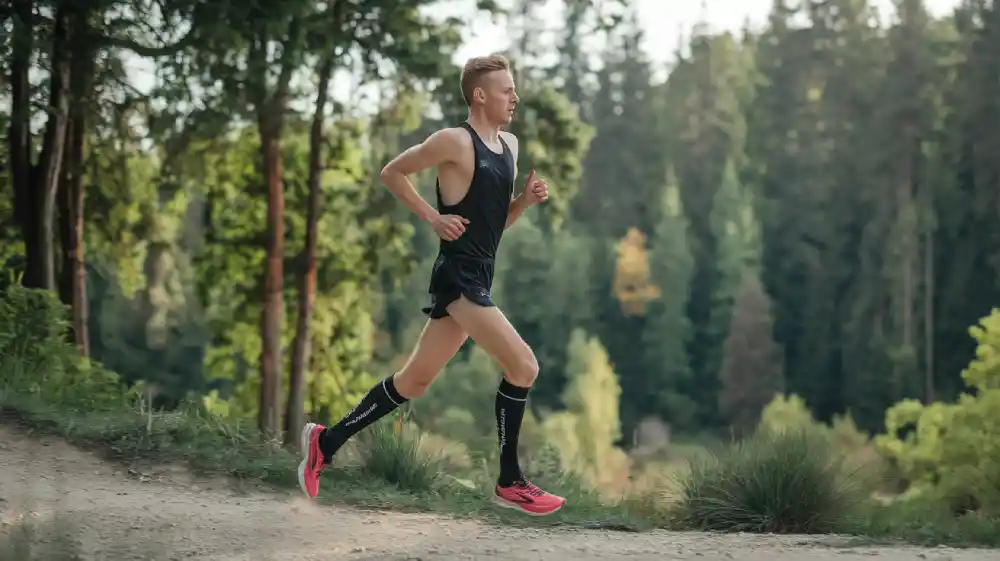
Market Growth and Customization: The Dual Opportunity in Compression Socks
The global compression sock market is experiencing robust expansion, driven by rising health awareness, athletic performance demands, and an aging population. Valued at approximately $715.2 million in 2022, the industry is projected to reach $1.1 billion by 2033, growing at a CAGR of 4.4% during this period. This growth is particularly pronounced in regions like North America, where the medical compression socks market was estimated at $327.9 million in 2023, and is expected to grow at a CAGR of 5.07% through 2030. The Asia-Pacific region is also witnessing significant adoption of wellness products, driven by a burgeoning middle class and increasing health consciousness.
Key demographics, including runners, healthcare patients, travelers, and professionals seeking ergonomic solutions, are propelling demand. Runners represent a critical segment, prioritizing performance enhancement and injury prevention. In fact, the athletes/sports segment accounted for approximately 33.96% of the medical compression socks market in North America in 2023.
This growth creates a prime opportunity for retailers and brands to differentiate through customization. Personalized compression sock designs are increasingly sought after, with athletes and consumers desiring unique aesthetics that reflect individuality or team spirit. Custom branding elevates this appeal; companies can embed logos or motivational messaging into their products. Recent trends indicate that 80% of consumers prioritize comfort when selecting socks, highlighting a shift towards more relaxed and stylish options.
Beyond aesthetics, tailored compression levels, materials, and fit cater to specific runner needs—marathoners may prefer lightweight, moisture-wicking fabrics, while trail runners prioritize durability and joint support. The demand for innovative materials continues to rise; for instance, sustainable fabrics are gaining traction as consumers become more environmentally conscious.
By aligning customization with market trends—such as the surge in running-related purchases and regional preferences—brands can capture niche audiences effectively. For instance, Asia-Pacific’s tech-savvy consumers may gravitate toward app-connected sizing tools, while North American athletes value eco-friendly custom options. Merging personalization with the sector’s upward trajectory not only future-proofs businesses but also builds customer loyalty in a competitive, fast-growing market.
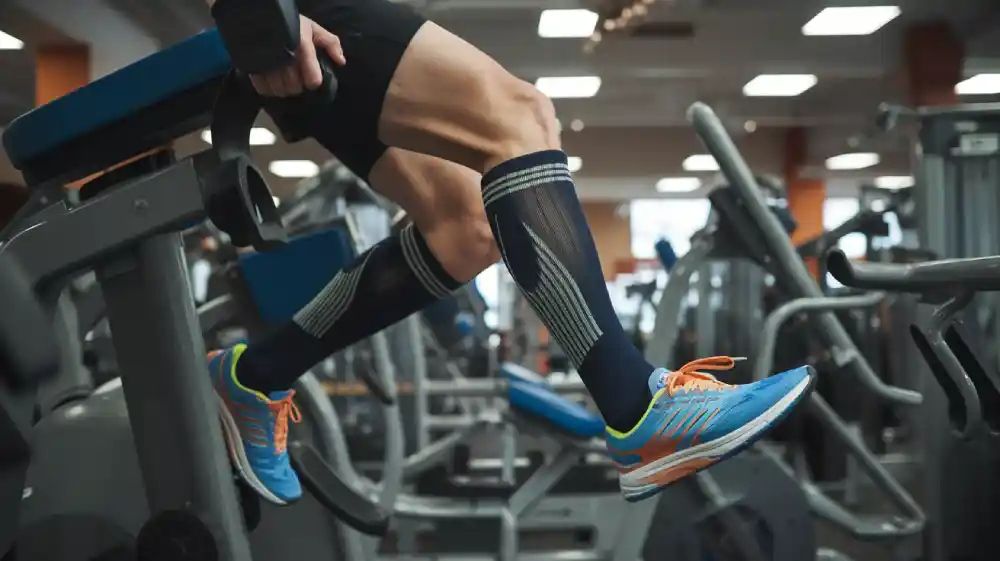
How Your Brand Can Stand Out in the Compression Sock Market
With the demand for compression wear on the rise, brands must differentiate themselves to stand out in a competitive market. By focusing on innovation, quality, and customer engagement, your brand can carve out a niche and attract loyal consumers.
Identifying Key Competitors in the Compression Sock Market
The compression sock market includes well-established brands like CEP, 2XU, and Swiftwick, which offer high-quality performance and recovery products. To compete effectively, understanding the strengths and weaknesses of these brands is essential. For instance, brands focusing on premium materials and performance enhancements have a significant edge. However, there’s room for differentiation by catering to specific consumer needs such as eco-conscious choices or customized design options. Researching your competitors’ pricing, features, and consumer feedback will help you identify untapped opportunities for growth.
How to Differentiate Your Product with Quality, Design, and Customer Service
- Quality: Consumers prioritize reliable, long-lasting products. Offering items made from durable, eco-friendly materials like recycled polyester, merino wool, or bamboo fibers will appeal to environmentally-conscious customers. The right blend of breathable fabrics and strong, yet flexible materials ensures both comfort and functionality. In addition, using OEKO-TEX certified yarns ensures that your products meet safety standards, which can also be a key selling point.
- Design: Customization is a powerful tool to make your product stand out. Offering flexible design options—such as different colors, patterns, and logo placements—allows customers to choose what best fits their style. This can be particularly valuable for brands looking to target niche markets. For example, running-focused socks can feature bold colors and logos, while medical-grade options can have more subtle, neutral designs. Additionally, providing mockup models or easy design tools for clients looking for branded socks can increase engagement.
- Customer Service: A positive customer experience drives brand loyalty. Offering easy returns, fast shipping, and responsive communication ensures your customers feel supported at every stage. Consider providing extra value through after-sales support such as detailed product guides, usage tips, and personalized recommendations. Excellent customer service, alongside a satisfaction guarantee, can set your brand apart and encourage repeat business.
Leveraging Innovation to Stay Ahead in a Competitive Market
Innovation is a key driver in staying ahead. Consider integrating the following strategies:
- Eco-Friendly Trends: Sustainability continues to grow as a major consumer demand. Align your brand with green practices by using recyclable materials and reducing your carbon footprint during manufacturing. For instance, offering compression wear made from sustainable fibers or using biodegradable packaging can help attract eco-conscious buyers and improve your brand’s market positioning. As noted by Textile Today, consumers are increasingly looking for products that support environmental protection, and offering these sustainable options will give you a competitive edge.
- Custom Compression Levels and Materials: Offering customized compression levels ensures that consumers can select the perfect fit for their specific needs, whether for sports, rehabilitation, or everyday use. You can provide a range of pressure options from light support (15-20 mmHg) to higher compression (30-40 mmHg). Additionally, customization extends to materials, allowing your product to cater to different user preferences, such as breathability, anti-slip features, and even antimicrobial properties for various use cases.
- Customized Packaging: Packaging isn’t just about protection—it’s an opportunity to boost your brand’s visibility. By offering customized packaging options—like eco-friendly boxes, bags, or tissue paper—you not only enhance your product’s appeal but also align with environmental values. This can help reinforce your brand’s commitment to sustainability while creating a premium buying experience. Whether your socks are sold online or in stores, providing branded packaging that matches your product’s identity can enhance recognition and attract more customers.
- Quality Assurance: Ensuring high-quality products is crucial for brand success. Implementing AQL inspection standards guarantees that your socks meet both customer expectations and international quality benchmarks. This commitment to quality will help build trust and credibility with your customers, ensuring they return to your brand for future purchases.
By focusing on quality, sustainable practices, and offering custom solutions, your brand can stand out and build a loyal customer base in the competitive compression sock market. Innovation, alongside excellent service and smart design, will position your brand as a market leader.
Conclusion: Why Investing in Compression Socks Is a Smart Business Move
The compression sock market is full of potential, with growing demand for products that enhance performance and recovery. By focusing on quality, innovative design, and sustainability, your brand can stand out and meet the needs of today’s active consumers.
Contact us today to partner with a trusted manufacturer and create high-quality, customized compression socks that elevate your brand and satisfy your customers.
FAQs
What are the key benefits of custom compression socks for my brand?
Custom compression socks can help differentiate your product line by offering personalized solutions for your customers. They provide performance benefits, such as reducing muscle fatigue, preventing injury, and improving recovery. By customizing compression levels, materials, and designs, you can cater to different customer needs, including athletes, medical patients, and active individuals, ultimately expanding your market reach.
Can custom compression socks be used for sports-specific needs, like running, cycling, or hiking?
Definitely! Compression socks can be customized to meet the specific needs of various sports. For example:
- Running socks may feature additional arch support and higher compression to improve endurance and reduce fatigue.
- Cycling socks might have extra cushioning in key areas to prevent chafing and enhance pedal comfort.
- Hiking socks may include moisture-wicking fabrics to keep feet dry and prevent blisters, along with added warmth for cold-weather use.
Each sport has different requirements, so offering specialized socks can help you cater to niche markets and enhance your brand’s appeal to dedicated athletes.
What factors should I consider before customizing the design of compression socks?
Before customizing the design, think about:
- Target audience: Who will be wearing these socks (athletes, medical patients, or general consumers)? Design choices should reflect the needs and preferences of your audience.
- Functionality: Customization should be driven by purpose. For example, athletes may need breathable, high-stretch fabrics, while medical socks may focus on comfort and therapeutic compression.
- Brand image: The design should align with your brand’s identity—whether it’s bold and vibrant or minimalistic and professional.
- Market trends: Consider current design trends—such as patterns, color schemes, or eco-friendly elements—to make sure your product resonates with your target demographic.
What kind of packaging should I choose for custom compression socks?
Packaging is a crucial part of the customer experience and your brand’s image. Consider:
- Eco-friendly packaging: Recyclable, biodegradable, or compostable materials align with sustainability trends and attract eco-conscious consumers.
- Retail-ready packaging: If selling in stores, packaging should be sturdy and visually appealing, showcasing your brand’s logo and product benefits.
- E-commerce packaging: For online sales, opt for packaging that protects the socks during shipping but is also visually compelling and easy to open.
- Customizable packaging: Offering custom packaging with branded graphics, product details, or eco-friendly messages adds value and enhances the unboxing experience.
Are there any specific certifications or approvals I should aim for when creating custom compression socks?
Depending on your target market, there are certifications and approvals that may be necessary. For example:
- FDA approval is important for medical compression socks sold in the U.S. for therapeutic use.
- CE marking is required for selling products in the European Union.
- OEKO-TEX certification ensures that materials are free from harmful substances.
Having the right certifications can give your brand a competitive edge and increase trust with consumers, especially in medical or wellness markets.
